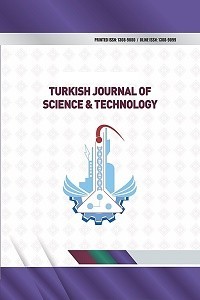Türkiye’de Yabani Olarak Yetişen Menengiç (Pistacia terebinthus L.) Tohumlarından Ekstrakte Edilen Yağın Karakterizasyonu
Elazığ’dan temin edilen menengiç tohumlarının kullanıldığı bu çalışmada, elde edilen yağın fiziksel ve kimyasal özellikleri incelenmiştir. Çünkü bu özellikler yağın kalitesi üzerinde oldukça etkili ve belirleyicidir. İlk olarak menengicin besin öğeleri açısından (ham yağ, ham protein, ham selüloz v.b.) bileşimi belirlenmiştir. Soxhlet metoduna göre, menengiç tohumlarının yağ içeriği % 47 olarak tespit edilmiştir. Farklı çözücü türleri kullanmak sureti ile elde edilen yağ örneklerinin serbest asitlik, peroksit değeri, sabunlaşma sayısı, iyot sayısı, sabunlaşmayan madde miktarı, tortu, viskozite, özgül ağırlık ve kırılma indisi gibi bir takım fiziksel ve kimyasal özellikleri tayin edilmiştir. Petrol eteri ile ekstrakte edilen menengiç yağının peroksit değeri açısından farklılık gösterdiği ve elverişli olmadığı sonucuna varılmıştır. Son olarak GC-FID kullanmak sureti ile yağ asidi bileşimi belirlenmiş ve menengiç yağının yaklaşık olarak % 74 oranında doymamış, % 26 oranında ise doymuş yağ asitlerinden ibaret olduğu tespit edilmiştir. Ortalama değerler üzerinden menengiç yağının % 45.8 oleik, % 23.93 linoleik (ω-6), % 0.47 linolenik (ω-3), % 3.78 palmitoleik, % 24.27 palmitik ve % 1.7 stearik asit içerdiği saptanmıştır. Oleik asit, linoleik asit ve palmitik asit menengiç yağının ana yağ asitleri olarak dikkate alınmıştır.
Anahtar Kelimeler:
Terebinth oil, composition of fatty acids, oil characterization, Pistacia terebinthus L.
Characterization of Extracted Oil from Seeds of Terebinth (Pistacia Terebinthus L.) Growing Wild in Turkey
In this study for which terebinth seeds obtained from Elazığ were used and the obtained oil physical/chemical properties are investigated. Because these properties are quite effective on oil quality. At first the composition of terebinth was determined in terms of nutritional elements (crude oil, crude protein, crude cellulose, etc.). According to soxhlet method, it was determined that terebinth seeds included 47% (w/w) oil. Some physical and chemical properties of oil samples such as free acidity, peroxide value, saponification number, iodine number, quantity of unsaponifiable matter, sediment, viscosity, specific gravity and refraction point were defined by using various types of solvents. It was concluded that the terebinth oil extracted with petroleum ether was different in terms of peroxide value and it was not sufficient when compared to oil samples obtained by other solvents. Finally, oil acidity composition was determined by using GC-FID and it was confirmed that terebinth oil was composed of about 74% unsaturated fatty acids and 26% saturated fatty acids. Through mean values, it was determined that terebinth oil included 45.8% oleic, 23.93% linoleic (ω-6), 0.47% linolenic (ω-3), 3.78% palmitoleic, 24.27% palmitic and 1.7% stearic acid. Oleic acid, linoleic acid and palmitic acid were considered as main fatty acids of terebinth oil.
- ISSN: 1308-9080
- Başlangıç: 2009
- Yayıncı: Fırat Üniversitesi
Sayıdaki Diğer Makaleler
İ. EMRE, D. TURGUT-BALIK, H. GENÇ, A. ŞAHİN
Türkiye Faunası İçin Yeni Bir Enochrus Thomson, 1859 (Coleoptera: Hydrophilidae) Kaydı
A. POLAT, G. E. TAŞAR, Ü. İNCEKARA
Pseudomonas aeruginosa ve rekombinant bakterisinin kalsiyum iyonunun varlığında piyosiyanin üretimi
Matris Diferansiyel Denklemler için Kronecker Çözümler
C*- Cebirlerinde Bazı Spektrum Özellikleri
